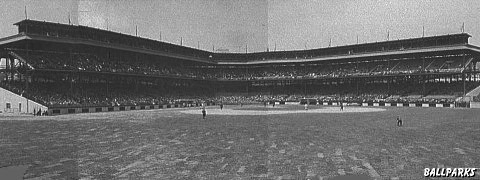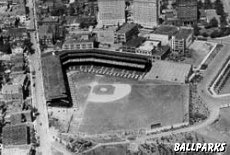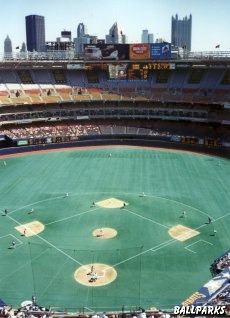HOMES OF THE
PITTSBURGH PIRATES
Since the year 1887, when they joined the National League,
the PITTSBURGH PIRATES
have called FIVE
different ball parks home.
1. Recreation Park---1887-1890
2. Exposition Park---1891-1909
3. Forbes Field---1909-1970
4. Three Rivers Stadium---1970-2000
5. PNC Park---2001-?
RECREATION PARK: 1887-1890
(No photographs AVAILABLE of Recreation Park)
When the Pittsburgh team (Alleghenies) entered the National League in
1887, Recreation Park was the their official home. The capacity
of the park was 17,000 and it was located several blocks north
(or away from the rivers) from the site of Three Rivers Stadium.
the park was built several blocks north of the rivers because of the
flooding problems closer to the rivers. The park was on a block
surrounded by Galveston Street, North Avenue and the Pittsburgh,
Ft Wayne & Chicago Railroad tracks. There is nothing there today
that would indicate that a ballpark was ever there.
The smallest crowd recorded at Recreation Park was
a mere half dozen paid fans, with a total of only
seventeen in attendance, on April 23, 1890 (it must have been a
COLD spring day in Pittsburgh).
The Pittsburgh team of the National League was known as the
Alleghenies until 1890. A rival baseball league (The Players League)
had folded after only one season of existence in 1890. All players
were expected to return to the teams they had played for in 1889.
But Pittsburgh signed a second baseman who had spent the previous
four seasons with the Philadelphia Athletics of the American
Association. The A's and their American Association brethern
accused Pittsburgh of "pirating" their player away from them.
Pittsburgh kept the second baseman and became known as the Pirates
thereafter.
EXPOSITION PARK: 1891-1909

As can be seen above, Exposition Park had no fences
in the outfield. This park was located very near the location
of Three Rivers Stadium. The Allegheny River flooded on July 4,
1902 and more than a foot of water covered large parts of the
outfield. Since the holiday was a perfect time for a doubleheader
and Brooklyn was in town, a special ground rule was created. All
outfield hits into the water were singles. The Pirates swept the
doubleheader.
The most notable event at Exposition Park was when the Buccos hosted
the first ever World Series in 1903.
Capacity: 16,000
Dimensions:
Left Field---400 feet
Center Field---450 feet
Right Field---400 feet
First Pirate game: April 22, 1891
Last Pirate game: June 29,1909
Surface: Grass
Capacity(1914): 16,000

Exposition Park was noted for its twin spires behind home plate on
the roof of the grandstand.
FORBES FIELD: 1909-1970

Forbes Field was a classic Major League Ballpark. It was named
after General John Forbes, a British general in the French and
Indian War, who in 1758 captured Fort Duquesne from the French and
renamed it Fort Pitt. The park was located in the Oakland district
of Pittsburgh, two miles east of downtown. Forbes Field provided a
picturesque setting that was unique in Major League Baseball. Many
people ridiculed the owner, Barney Dreyfus, for locating the park in
Oakland, saying that it was too far from downtown businessmen.
However, Forbes Field survived much longer than any of its critics
thought she would. She opened her doors during the Pirate World
Championship year of 1909 and closed her gates in 1970 when the
Pirates won the Eastern Division Flag.
MAJOR LEAGUE FIRSTS and
INTERESTING FACTS ABOUT FORBES FIELD:
It was the first park constucted of concrete
and steel.
On July 17, 1914 the Pirates lost a 21 inning
game to the Giants and
both pitchers went the distance!
It hosted the last ever MLB tripleheader.
In the 1920s cars were repaired and sold under
the left field
bleachers.
The first radio broadcast of a game occured
here in 1921.
It was the first park in MLB to have foam
rubber crash pads on its
outfield wall.
It was host to the World Series four times
(1909, 1925, 1927, 1960) and the
All Star Game twice (1944, 1959). The 1944 classic was the
first ever All Star Game to be held at night.
On September 15, 1963 the Giants played an
all-brother outfield
(Felipe, Jesus and Matty Alou).
There was never a no-hitter in the sixty one
year history of Forbes
Field.
The fans in the upper corner of the leftfield
bleachers could not
see home plate because the third base stands were in the way.
In the outfield the bottoms of the light towers were in play.
Eighteen homers were hit over the right field
roof by ten different
players. On May 25, 1925, as Babe Ruth finished his career with the
Boston Braves, he hit his last three home runs on May 25, 1935 in
Forbes Field, with the last one clearing the right field roof. The
other players to follow the Babe were Ted Beard, Mickey Mantle, Wally
Moon, Bob Skinner(2), Eddie Mathews(2), Jerry Lynch, Rusty Staub,
Willie McCovey and Willie Stargell(7).

The dimensions of Forbes Field changed many
times over the years.
The original dimensions were:
Left 360 feet
Center 462 feet
Right 376

The final dimensions were:
Left 365 feet
Left center 406 feet
Deepest part of the park 457 feet
Center 435 feet
Right center 408 feet
Right 300 feet
The right field stands were added after the
1925 season, dropping the
home run distance from 376 to 300 feet.
The 86 foot right field screen was added in
1938.
In 1940, floodlights and a PA system were added.
Forbes Field never had advertisement on its
outfield walls, but in June 1943 until the end of the season, a 32 foot high wooden US Marine was erected in the outfield to advertise war bonds.
Left center field was so deep that the batting
cage was stored there during the games.
In order to boost home run production, in 1947
a utility fence was installed in left field at the 335 feet mark. This area was first known as Greenberg Gardens after Hall of Famer Hank Greenberg, who finished his career in Pittsburgh. Until the end of the 1953 season it was also known as Kiner's Korner, after Pittsburgh slugger Ralph Kiner. In 1954 the left field distance returned to 365 feet with the giant scoreboard serving as the fence in straight away left.

Capacity: 35,00
Largest crowd: 44,932 on September 23, 1956 vs
the Dodgers.
Smallest crowd: 200 fans on June 10, 1938 vs
the Phillies.
The outfield brick wall was 12 feet high.
The first night game was held June 4, 1940
against the Braves.
Beer was never sold at Forbes Field but until 1960 fans could carry it into the park. Many fans would buy an extra seat so that they would have a place for their case of beer!
The backstop ranged from 120 to 75 feet---
other major league average
about 60 feet.
In 1956 Dale Long, Pirate first baseman
homered in his eighth straight game to set a MLB record.
THREE RIVERS STADIUM: 1970-2000

The stadium was named after the three rivers, the Allegheny,
Monongahela and Ohio, that converge just to the south of its outer
walls. The triangle that these converging rivers form, Pittsburgh's
Golden Triangle, the Point Park water fountain, the stadium itself
and Mt. Washington just to the south of the rivers, (with its
Duquesne Incline cars), all create a panoramic combination that is
unique to Pittsburgh. TRS sits almost precisely on the site of
Exposition Park (1891-1909). The site of TRS was also very near the
location of many battles fought by General George Washington, in the
French and Indian War, over the possesion of Fort Duquesne which
later became Fort Pitt. Three Rivers Stadium (TRS) opened on
July 16, 1970. Although there was not even one no-hitter pitched in
Forbes Field, from 1909 to 1970; there was a no-hitter pitched in
TRS within the second year of occupancy. On August 14, 1971, Bob
Gibson of the St. Louis Cardinals pitched a no-hitter against the
Pirates.

MAJOR LEAGUE FIRSTS & INTERESTING EVENTS AT
THREE RIVERS STADIUM:
With their new stadium, the Pirates unveiled
new uniforms for their team. The Bucs were the first team in MLB to
wear Knit style uniforms.
TRS hosted the first playoff game ever played
on artificial turf in 1970.
TRS also hosted the first ever night World
Series game during the 1971 Series.
The stadium also has hosted two All-Star
Games (1974, 1994) and two World Series (1971, 1979) and several
Division Championship Series.
In 1972, in the last game of the season,
Roberto Clemente pounded a double off the Mets' Jon Matlack. This
was Clemente's 3,000th hit of his career and tragically, it was also
his last. The following offseason Roberto died in a plane crash
while assisting earthquake victims.
The seventy foot upper deck became a new
target for long ball hitters at TRS almost immediately upon
occupancy. Ten sluggers have hit a total of thirteen homers into
the upper deck since the 1970 opening. Some of those long balls are
commemerated with numbers painted on the upper deck seats. Here is a
listing of those monumental drives:
1. Willie Stargell 8/9/70
2. Willie Stargell 5/30/71
3. Willie Stargell 6/20/71
4. Bob Robertson 7/16/71
5. Willie Stargell 5/31/71
6. Greg Luzinski 4/18/79
7. Bobby Bonilla 7/12/87
8. Howard Johnson 4/15/91
9. Jeff Bagwell 5/5/91
10. Mark Whiten 8/11/93
11. Glenallen Hill 5/6/94
12. Jeff Bagwell 5/29/96
13. Devon White 6/16/96
A few Forbes Field landmarks were transferred
to TRS.
The Honus Wagner statue was brought from Schenley Park to
reside at Gate C.
The Dreyfuss Memorial, which used to sit in play in center field at
Forbes, now sits inside Gate A.
The Allegheny Club at TRS has the
8-by-12 foot section of the Forbes Field outfield wall where Bill
Mazeroski's World Series winning home run went out of the park in
1960. The Club also has 12 Romanesque window frames from Forbes and
a plaque that commemorates Babe Ruth's 714th Home Run (hit at Forbes
Field).
A Roberto Clemente statue is found at Gate A
and was dedicated in 1994 during the All Star Game celebration.
There is also a statue of Art Rooney (Steeler owner) outside the
stadium between Gates C and D.
Capacity: 48,044
Largest crowd: 59,568---All Star Game,
July 12,1994
Largest crowd, Pirate game: 57,533---October
10, 1991 vs Braves
Dimensions:
Foul Lines: 335 feet
Power Alleys: 375 feet
Playing Surface:
Tartanturf, 1970-1982
Astroturf, 1983-2000
PNC PARK: 2001-?
In the early 1990's, there was a "retro revolution" in MLB ballpark
design. Baltimore led the way with its Oriole Park at Camden Yards
and was closely followed by Cleveland's Jacpbs Field and Coors Field
in Denver. A new ballpark became part of the solution to icrease a
team's revenue flows. When Kevin McClatchy's ownership group bought
the Pirates in 1996, part of his purchase agreement included a
pledge by local officials to work towards a new ballpark in
Pittsburgh. The ownership also had a clause in their contract that
the team could be placed for sale if ballpark funding was not in
place by February 1, 1998.

The climate around MLB at the time had several teams considering
relocating, and eager ownership groups were looking to purchase
existing baseball clubs for the North Carolina and Washington D.C.
markets. On March 9, 1998, Pittsburgh's mayor and the Allegheny
County Commissioners announced a financing plan for a new ball park.
On March 17, 1998, the Pirates unveiled a detailed model of their
new ballpark which generally received rave reviews. The local
funding plan was approved on July 9, 1998; and after a false start
in November, the state funding portion was added on February 3,
1999.
A site on the north side of the Allegheny River was chosen for the
park. It will be located just to the west of Three Rivers Stadium (which was the site of Exposition Park). The park is located between the Fort Duquesne Bridge and the former Sixth Street Bridge (the Sixth Street Bridge has now been renamed the Roberto Clemente Bridge).
The ballpark design is unique from both Camden Yards and Jacobs. It
is be a 2-tiered design that is more like Wrigley Field or Fenway
Park. The park is the smallest in MLB (next to Fenway Park,
which is planned for replacement soon). With 38,000 seats, each
seat will provide intimat views of the field. Seats behind home
plate will only be 50 feet from the batter's box - this is even
closer than the distance from the pitcher's mound to home plate.
Seats down the baseline will only be 45 feet from 1st and 3rd
base. Of the total 38,000 seats, 26,000 seats (or 68%) are on
the field level, with the remaining 10,400 seats being located in
the upper deck.
Some early criticisms of the designs questioned if a 38,000 fan
park is large enough - compared to the 42,000-45,000 parks built
recently. However, most felt that baseball is best viewed from a
seat close to the action. PNC Park provides intimate views that
other parks will envy. A smaller park makes each set better. As a
park expands up and out to allow for more seating, every additional
seat is moved farther away from the field. The height of the
highest seat in PNC has been reduced by 32% from the height of the
highest seat in TRS. If every seat in PNC was filled for every
Pirate game , the annual attendance would be over 3 million. The
best seasonal attendance in TRS since 1971 has been just over 2
million. Most think that the size of PNC Park is just right for
Pittsburgh.
The outside design and setting of PNC Park is dramatic. From it's
north side location, the park will provide a dramatic sweeping view
of downtown Pittsburgh. The Allegheny River and the Roberto
Clemente Bridge will also provide prominent landmarks in the
ballpark vista. When a TV camera shows the scene from behind home
plate, the audience will have no doubt that this game is televised
from Pittsburgh, Pennsylvania.
The Roberto Clemente Bridge also provides a functional use as a
pedestrian walkway from downtown to PNC Park.The bridge is planned
to be closed to vehicles on game day and to make the bridge part of
the ballpark experience. There will be a wonderful view into the
ballpark from the bridge.

The park has a brick front, steel structure, terra cotta tiled
pilasters, dramatic masonary arches along the homeplate entryway,
and a flat green steel roof that provides distinct memories of
Forbes Field. Even small details such as diamond designs above the
arches are throw backs to Forbes.
Pirate owner Kevin McClatchy stated "PNC Park offers all of the
intamacy of beloved Forbes Field with all of the modern amenities
that today's baseball fans expect."
The naming agreement for the Park with PNC is for 20 years. In
addition to the $1.4 million per year for the naming rights, PNC
has a package for other signs (most likely one behind home plate),
a marquee outside the park, as well as branch office and ATM
rights in the park.
NOTE: Dan acknowledges the research and assistance received
from the "Fun Facts About Pittsburgh's Ball Parks" web page for the
preparation of this page.
E-Mail Dan at wmyr@qtm.net.










